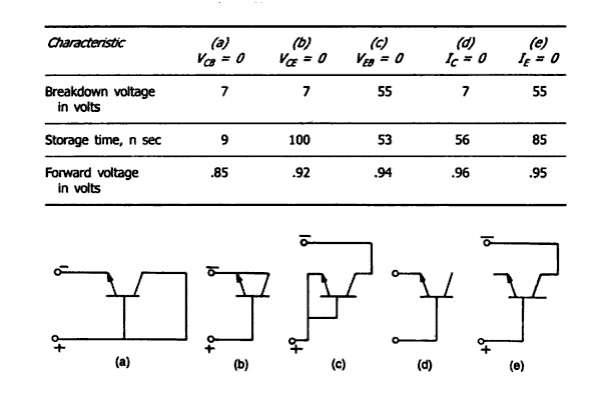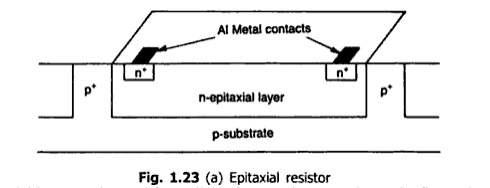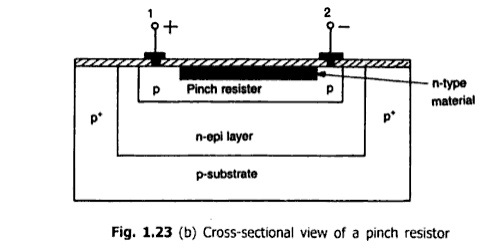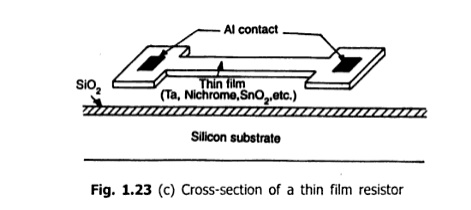The diode used in integrated circuits are made using transistor structures in one of the five possible connections. The three most popular structures are shown in figure. The diode is obtained from a transistor structure using one of the following structures.
1. The emitter-base diode, with collector short circuited to the base.
2. The emitter-base diode with the collector open and
3. The collector –base diode, with the emitter open-circuited.
The choice of the diode structure depends on the performance and application desired. Collector-base diodes have higher collector-base arrays breaking rating, and they are suitable for common-cathode diode arrays diffused within a single isolation island. The emitter-base diffusion is very popular for the fabrication of diodes, provided the reverse-voltage requirement of the circuit does not exceed the lower base-emitter breakdown voltage.

1. Integrated Resistors:
A resistor in a monolithic integrated circuit is obtained by utilizing the bulk resistivity of the diffused volume of semiconductor region. The commonly used methods for fabricating integrated resistors are 1. Diffused 2.epitaxial 3. Pinched and 4. Thin film techniques.
2. Diffused Resistor:
The diffused resistor is formed in any one of the isolated regions of epitaxial layer during base or emitter diffusion processes. This type of resistor fabrication is very economical as it runs in parallel to the bipolar transistor fabrication. The N-type emitter diffusion and P-type base diffusion are commonly used to realize the monolithic resistor.
The diffused resistor has a severe limitation in that, only small valued resistors can be fabricated. The surface geometry such as the length, width and the diffused impurity profile determine the resistance value. The commonly used parameter for defining this resistance is called the sheet resistance. It is defined as the resistance in ohms/square offered by the diffused area.
In the monolithic resistor, the resistance value is expressed by R = Rs 1/w
where R= resistance offered (in ohms)
Rs = sheet resistance of the particular fabrication process involved (in ohms/square)
l = length of the diffused area and w = width of the diffused area.
The sheet resistance of the base and emitter diffusion in 200Ω/Square and 2.2Ω/square respectively. For example, an emitter-diffused strip of 2mil wide and 20 mil long will offer a resistance of 22Ω. For higher values of resistance, the diffusion region can be formed in a zig-zag fashion resulting in larger effective length. The poly silicon layer can also be used for resistor realization.
3. Epitaxial Resistor:

The N-epitaxial layer can be used for realizing large resistance values. The figure shows the cross-sectional view of the epitaxial resistor formed in the epitaxial layer between the two N+aluminium metal contacts.
4. Pinched resistor:

The sheet resistance offered by the diffusion regions can be increased by narrowing down its cross-sectional area. This type of resistance is normally achieved in the base region. Figure shows a pinched base diffused resistor. It can offer resistance of the order of mega ohms in a comparatively smaller area. In the structure shown, no current can flow in the N-type material
since the diode realized at contact 2 is biased in reversed direction. Only very small reverse saturation current can flow in conduction path for the current has been reduced or pinched. Therefore, the resistance between the contact 1 and 2 increases as the width narrows down and hence it acts as a pinched resistor.
5. Thin film resistor:

The thin film deposition technique can also be used for the fabrication of monolithic resistors. A very thin metallic film of thickness less than 1μm is deposited on the silicon dioxide layer by vapour deposition techniques. Normally, Nichrome (NiCr) is used for this process. Desired geometry is achieved using masked etching processes to obtain suitable value of resistors. Ohmic contacts are made using aluminium metallization as discussed in earlier sections.
The cross-sectional view of a thin film resistor as shown in figure. Sheet resistances of 40 to 400Ω/ square can be easily obtained in this method and thus 20kΩ to 50kΩ values are very practical.
The advantages of thin film resistors are as follows:
1. They have smaller parasitic components which makes their high frequency behaviour good.
2. The thin film resistor values can be very minutely controlled using laser trimming.
3. They have low temperature coefficient of resistance and this makes them more stable.
The thin film resistor can be obtained by the use of tantalum deposited over silicon dioxide layer. The main disadvantage of thin film resistor is that its fabrication requires additional processing steps.

